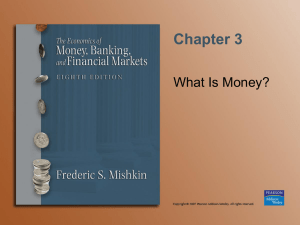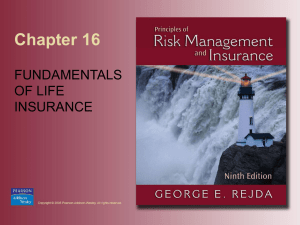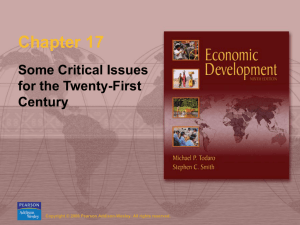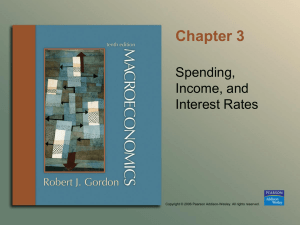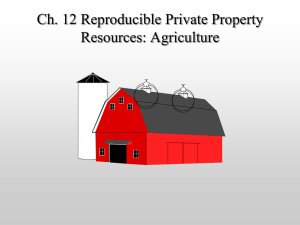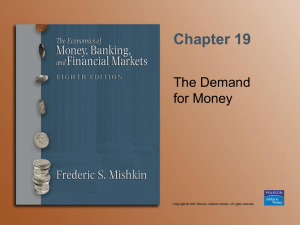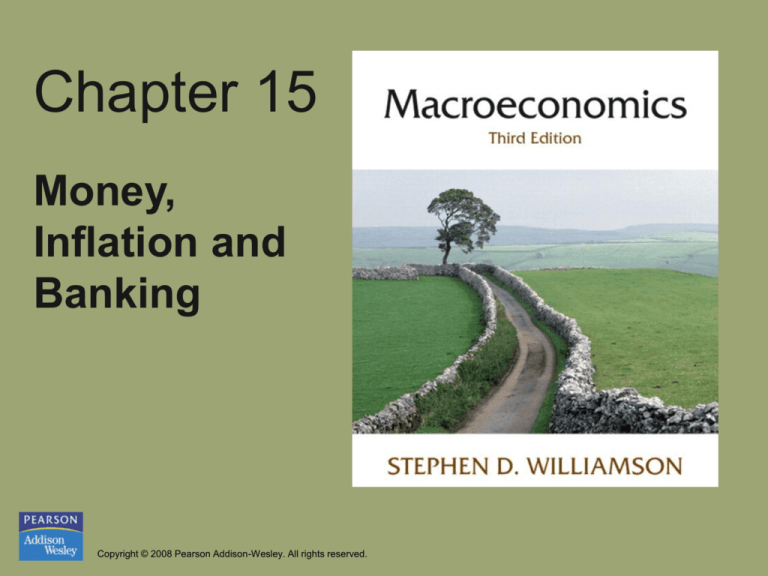
Chapter 15
Money,
Inflation and
Banking
Copyright © 2008 Pearson Addison-Wesley. All rights reserved.
Chapter 15 Topics
• Alternative forms of money.
• Money and the absence of double coincidence of
wants.
• The causes and effects of long-run inflation.
• Financial intermediation and banking.
Copyright © 2008 Pearson Addison-Wesley. All rights reserved.
15-2
Alternative Forms of Money
• Commodity money (made of precious metal)
• Circulating private bank notes (local currency)
• Commodity-backed paper currency
(entitled to gold, save cost of carrying goods)
• Fiat money (valueless, believe to be accepted in future
transaction)
• Transactions deposits at banks (purchase by check or
debit card)
Copyright © 2008 Pearson Addison-Wesley. All rights reserved.
15-3
Role of Money
• Barter trade: exchange of goods for goods.
• Money trade: exchange of goods for money.
• Why do people need to use money as medium of
exchange (existence of money trade) ?
• Barter exchange is difficult in highly-developed,
specialized economies.
For example, lack of double coincidence of wants
problem happens all the time.
• Money trade helps to fix this problem, and therefore,
promote transactions and welfare.
Copyright © 2008 Pearson Addison-Wesley. All rights reserved.
15-4
Lack of Double-Coincidence of
Wants and the Role of Money
• An economy with many goods and people are specialize in what
they produce and consume.
• Ex: Person I produces good 1, but need to consume good 2.
• Trade between person I and II without money can be performed
if person II produces good 2 and consumes good 1. That is,
double-coincidence of wants occurs.
• In a economy with many goods, a successful trade is hard to
perform due to lack of double-coincidence of wants problem.
• To pursue a successful trade, people have to search hard, which
is costly. This hurts welfare (transactions are low).
• Search costs are reduced dramatically if everyone accepts
money.
Copyright © 2008 Pearson Addison-Wesley. All rights reserved.
15-5
Figure 15.1 An Absence-of-DoubleCoincidence Economy
Copyright © 2008 Pearson Addison-Wesley. All rights reserved.
15-6
Figure 15.2 Good 1 as a Commodity
Money in the Absence-of-DoubleCoincidence Economy
Good 1 is served as
commodity money.
More transactions happen
with commodity money.
Copyright © 2008 Pearson Addison-Wesley. All rights reserved.
15-7
Figure 15.3 Fiat Money in the Absenceof-Double-Coincidence Economy
With money as medium
of exchange, successful
transactions increase greatly.
Copyright © 2008 Pearson Addison-Wesley. All rights reserved.
15-8
The Effects of Long-Run
Inflation
• Money may not be neutral in SR (sticky nominal wage
models in Ch. 12).
• Money is neutral in LR (a change in level of Ms has no
long-run effect when prices can adjust freely).
• However, a change in growth rate of Ms has LR effect
on real variables (not superneutral).
• Why: an increase in the money growth rate increases
the inflation rate and the nominal interest rate, and
reduces employment and output.
Copyright © 2008 Pearson Addison-Wesley. All rights reserved.
15-9
Figure 15.4 Scatter plot of the Inflation
Rate vs. the Growth Rate in M0 for the
United States, 1960–2006
Conventional Wise:
the sustained inflations are
usually the result of sustained
growth in Ms.
The best fit to the set of
points is the positively sloped
straight line in the figure. So
the two variables are positively
correlated, though not strongly so.
Copyright © 2008 Pearson Addison-Wesley. All rights reserved.
15-10
Equation 15.1
Assume that the central bank causes the money
supply to grow at a constant rate x.
M’: money supply in future period.
M: money supply in current period.
x: growth rate of money supply from current period to future period.
Copyright © 2008 Pearson Addison-Wesley. All rights reserved.
15-11
Equation 15.2
In equilibrium, nominal money supply equals
nominal money demand.
Copyright © 2008 Pearson Addison-Wesley. All rights reserved.
15-12
Equation 15.3
Nominal money supply also equals nominal
money demand in the future period.
Copyright © 2008 Pearson Addison-Wesley. All rights reserved.
15-13
Equation 15.4
Combine the previous two equations.
Copyright © 2008 Pearson Addison-Wesley. All rights reserved.
15-14
Implication of Equation 15.4
• With constant growth rate in Ms, all real
variables stay constant, and the growth in Ms is
reflected by growth in price level.
• Money growth rate = inflation rate
That is, x = i
• Q: if x increases, what happens to real variables?
Copyright © 2008 Pearson Addison-Wesley. All rights reserved.
15-15
Equation 15.5
The consumer’s intertemporal marginal
condition (recall two-period model in Ch.8).
Copyright © 2008 Pearson Addison-Wesley. All rights reserved.
15-16
Equation 15.6
Marginal condition reflecting the consumer’s
tradeoff between current leisure and future
consumption:
Wage income cannot be spent on consumption goods until next period,
The effective real wage is, therefore, P w / P’.
Recall from Ch.4, the MRS l , C = w (real wage)
Copyright © 2008 Pearson Addison-Wesley. All rights reserved.
15-17
Equation 15.7
Marginal condition reflecting the consumer’s
tradeoff between current leisure and current
consumption:
R: nominal interest rate.
The RHS is the relative price of leisure to consumption.
When R increases, leisure becomes cheaper, so consumer trades C for l.
Copyright © 2008 Pearson Addison-Wesley. All rights reserved.
15-18
Figure 15.5 The Long-Run Effects of
an Increase in the Money Growth Rate
Ns curve shifts as a result of substitution effect.
Copyright © 2008 Pearson Addison-Wesley. All rights reserved.
15-19
Conclusion
• A change in the growth rate of money supply has real
effects in that higher growth in money leads to higher
inflation, which changes consumer’s decision on leisure
and consumption, which affects equilibrium output and
employment.
• Moreover, higher inflation increases the nominal
interest rate, which is opportunity cost of carrying
money. As a result, consumers tend to hold less money
balances.
Copyright © 2008 Pearson Addison-Wesley. All rights reserved.
15-20
The Friedman Rule
• Inflation causes an inefficiency, in that it distorts
intertemporal decisions (more leisure, less consumption
goods).
• The Friedman rule is a prescription for monetary
growth that eliminates the inefficiency caused by
inflation.
• The Friedman rule specifies that the money stock grow
at a rate that makes the nominal interest rate zero.
Copyright © 2008 Pearson Addison-Wesley. All rights reserved.
15-21
Equation 15.9
Pareto optimality requires that (recall from Ch.5)
Copyright © 2008 Pearson Addison-Wesley. All rights reserved.
15-22
Equation 15.10
In a competitive equilibrium (recall from Ch.4),
Copyright © 2008 Pearson Addison-Wesley. All rights reserved.
15-23
Equation 15.11
Also, in a competitive equilibrium,
Compared with Equation 15.9, the CE is not PO if R>0.
Inefficiency arises due to the positive nominal interest rate.
Particularly, with R>0, too much leisure is consumed, which leads to
lower labor supply, lower outputs and lower consumption in economy.
Copyright © 2008 Pearson Addison-Wesley. All rights reserved.
15-24
How to Restore Efficiency?
Optimal Monetary Policy - Friedman
Rule
• To restore efficiency, one needs to set R = 0.
• This implies x = -r < 0. That is, the money supply
decreases over time. So the optimal policy to for CB to
generate a deflation that continues forever.
• By doing so, because of zero opportunity cost of
carrying money, all transactions are carried out by
money.
• Efficiency is restored since consumers do not consumer
leisure too much, which increases labor supply, and
therefore, output.
Copyright © 2008 Pearson Addison-Wesley. All rights reserved.
15-25
Why not Popular in Practice
• In practice, no central bank appears to have adopted a
Friedman rule to guide monetary policy.
• Friedman rule is not followed by CB.
• Reason 1: Welfare losses from moderate inflation is
quite small.
• Reason 2: Liquidity trap: monetary policy does not
function any more with zero nominal interest rate.
– With R = 0, money and bond are identical assets. So the open
market operation would have no real effect in SR.
Copyright © 2008 Pearson Addison-Wesley. All rights reserved.
15-26
Properties of Assets
• Rate of return: payoff on the asset over some specified
period of time divided by the initial investment in the
asset, minus one.
• Risk: the risk that matters is the one that an asset
contributes to the whole portfolio.
• Maturity: the time it takes for an asset to pay off.
• Liquidity: a measure of how long it takes to sell an asset
for its market value and of how high the costs are of
selling the asset.
Copyright © 2008 Pearson Addison-Wesley. All rights reserved.
15-27
Defining Characteristics of
Financial Intermediaries
1. Borrow from one group of economic agents
and lend to another.
2. Well-diversified with respect to both assets and
liabilities.
3. Transform assets.
4. Process information.
Copyright © 2008 Pearson Addison-Wesley. All rights reserved.
15-28
The Diamond-Dybvig Banking
Model
• Capture key features of banks.
• Explain why bank run (bankruptcy) may happen.
• What should government do to prevent bank run.
Copyright © 2008 Pearson Addison-Wesley. All rights reserved.
15-29
The Diamond-Dybvig Banking
Model
• Three periods, T = 0, 1, 2.
• N consumers with endowment of one unit of good at T=0.
• Production function: convert one unit of good at T=0 to (1+r)
unit of good at T=2.
• If production is interrupted at T=1, receive one unit of good at
T=1. And production stops with nothing produced at T=2.
• Two types of consumers: early (consume in period 1) and late
(consume in period 2).
• Information on type is unknown at T=0, but reveal at T=1. At
T=1, with prob. t to be early type and (1-t) to be late type.
Copyright © 2008 Pearson Addison-Wesley. All rights reserved.
15-30
Figure 15.6 The Utility Function For a
Consumer in the Diamond–Dybvig Model
Copyright © 2008 Pearson Addison-Wesley. All rights reserved.
15-31
Equation 15.12
• The marginal rate of substitution of early
consumption for late consumption is
Copyright © 2008 Pearson Addison-Wesley. All rights reserved.
15-32
Figure 15.7 The Preferences of a
Diamond–Dybvig Consumer
Copyright © 2008 Pearson Addison-Wesley. All rights reserved.
15-33
Optimal Arrangement without Bank
• At T=0, the optimal arrangement for consumers
is
c1 = 1, c2 = 1 + r.
• However, the arrangement with bank is better
than this one.
Copyright © 2008 Pearson Addison-Wesley. All rights reserved.
15-34
Bank and Deposit Contract
• Offer deposit contract (c1, c2) to consumers. That
is, early consumers receive c1 at T=1, and late
consumer receive c2 at T=2.
• Banks behave competitively, so earn zero profits.
• Bank cannot tell who is who. That is, if late type
come to withdraw at T=1, bank offers them c1.
• However, the contract is designed in a way that
late type have no incentive to withdraw early.
Copyright © 2008 Pearson Addison-Wesley. All rights reserved.
15-35
Equation 15.13
• First constraint that a deposit contract must
satisfy is
At T=0, all consumers deposit goods at banks (N goods at T=0) and banks
invest all deposits.
At T=1, banks interrupt x fraction of investment to pay C1 to early consumers.
Copyright © 2008 Pearson Addison-Wesley. All rights reserved.
15-36
Equation 15.14
Second constraint that a deposit contract must
satisfy is
At T=2, banks obtain (1+r)(1-x) N goods from production that is not interrupted
and pay C2 to late consumers.
Copyright © 2008 Pearson Addison-Wesley. All rights reserved.
15-37
Equation 15.15
Combine the two constraints to get one:
Lifetime budget constraint for bank, which governs how
the deposit contract (c1, c2) is determined.
Copyright © 2008 Pearson Addison-Wesley. All rights reserved.
15-38
Equation 15.16
Re-write the constraint:
Copyright © 2008 Pearson Addison-Wesley. All rights reserved.
15-39
Figure 15.8 The Equilibrium Deposit
Contract Offered by the Diamond–Dybvig
Bank
A: optimal deposit contract.
D: optimal arrangement without bank.
B: arrangements where c1 = c2.
Two features at A:
1. c2 > c1.
2. c1 > 1, c2 < (1 + r)
Copyright © 2008 Pearson Addison-Wesley. All rights reserved.
15-40
Bank Run
• The fact that bank supplies consumers with insurance
against the need for liquidity leaves the bank open to
bank run.
• Good equilibrium: with optimal deposit contract, early
consumers withdraw at T=1, and late consumers
withdraw at T=2.
• Bad equilibrium: with optimal deposit contract, all
consumers withdraw at T=1. Bank run happens because
bank cannot satisfy total withdrawal demand at T=1.
(N-1)c1 > N
Copyright © 2008 Pearson Addison-Wesley. All rights reserved.
15-41
Deposit Insurance
• Remove the incentive of late consumers to
withdraw early by assuring them that they will
receive c2 given by bank deposit contract.
• In the U.S., deposits in depository institutions
are insured up to $100,000 by the Federal
Deposit Insurance Corporation. So even banks
fail, each depositor can receive the value of their
deposit up to $100,000.
Copyright © 2008 Pearson Addison-Wesley. All rights reserved.
15-42

